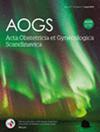Uptake of orally administered tranexamic acid in women during active labor: A pilot intervention study on prophylactic treatment of postpartum hemorrhage
Abstract
Introduction
Postpartum hemorrhage is the leading cause of maternal mortality worldwide. Several studies have confirmed that tranexamic acid is effective in treating postpartum hemorrhage once started, but its prophylactic effect is under debate. As of now, most studies involve intravenous administration, and the uptake of tranexamic acid in women during active labor is unknown. This is a pilot study in preparation for a larger randomized controlled trial on the prophylactic effect of oral tranexamic acid on postpartum hemorrhage. The study aims to assess the uptake of oral tranexamic acid during active labor.
Material and Methods
Our study is a pilot intervention study. The study population consisted of 51 women ≥36 gestational weeks with planned vaginal delivery at Södersjukhuset, Stockholm, from December 2022 through February 2023. The participants were randomized 1:1:1:1 to receive 2 g of tranexamic acid as an oral solution, tablets, effervescent tablets, or 1 g of intravenous tranexamic acid, near full cervical dilatation. Blood samples were taken before and 30, 60, 120, 240, 360, and 480 min after tranexamic acid administration. Plasma concentration of tranexamic acid was measured using liquid chromatography–tandem mass spectrometry. Mean values were compared between groups using analysis of variance. Our main outcome measures were time to therapeutic level, duration in therapeutic interval, and maximum plasma concentration of tranexamic acid.
Results
Therapeutic level (5.0 mg/L) was reached at the 2-h time point for oral (7.11 ± 3.31 mg/L) and the 30-min time point for intravenous forms (30.6 ± 15.0 mg/L). Duration in therapeutic intervals for oral and intravenous forms was 6 and 3.5 h (p < 0.007). Peak plasma concentrations for oral and intravenous forms were 10.2 ± 3.9 mg/L and 30.6 ± 15.0 mg/L, respectively (p < 0.001). Time-to-therapeutic level (p = 0.08), duration in therapeutic interval (p = 0.92), or peak concentration (p = 0.73) did not differ between oral forms. Overall, 37 women (88%) found the intake of oral tranexamic acid during active labor acceptable.
Conclusions
All oral forms of tranexamic acid show similar and adequate uptake when administered during labor. Uptake is lower and slower compared with intravenous administration, but the duration in the therapeutic interval is longer.


 求助内容:
求助内容: 应助结果提醒方式:
应助结果提醒方式:


